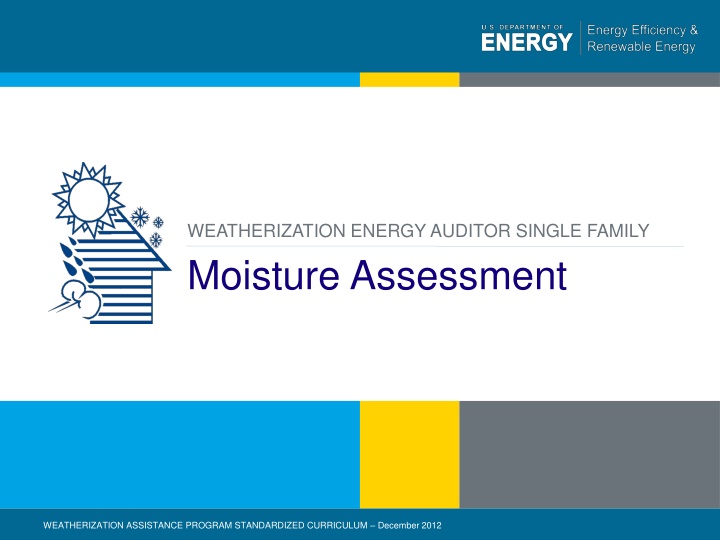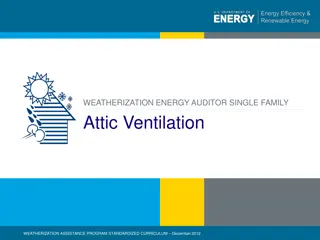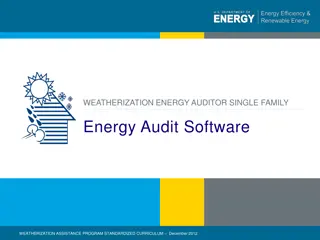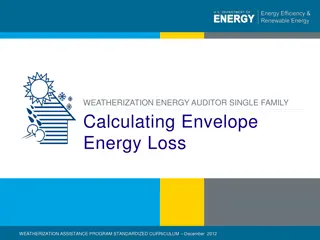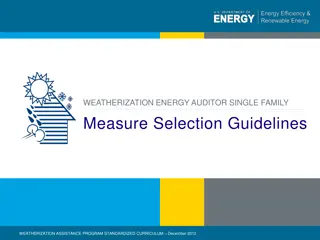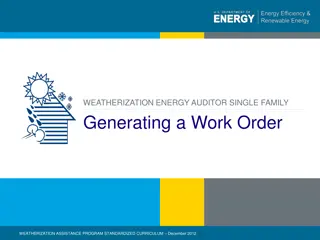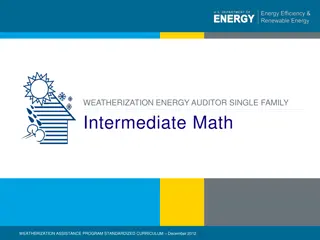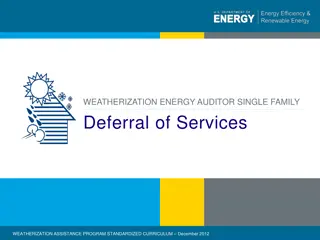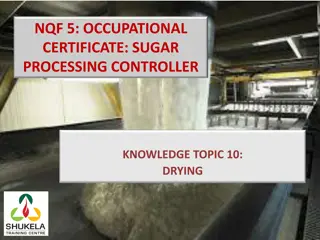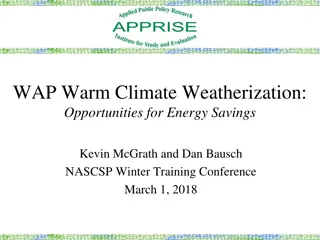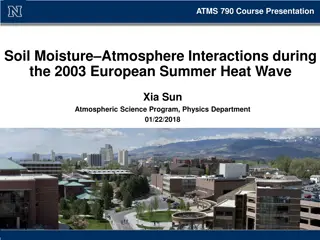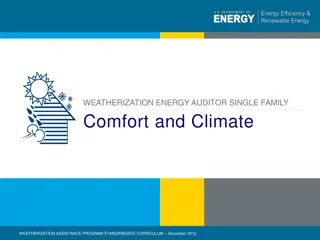Moisture Assessment in Weatherization Energy Auditing for Single Family Homes
This December 2012 curriculum focuses on moisture assessment in the weatherization energy auditing process for single-family homes. It covers analyzing symptoms of moisture problems, identifying sources, understanding moisture control strategies, and using assessment tools. The training aims to equip participants with the knowledge needed to effectively address moisture issues in residential settings.
Download Presentation

Please find below an Image/Link to download the presentation.
The content on the website is provided AS IS for your information and personal use only. It may not be sold, licensed, or shared on other websites without obtaining consent from the author.If you encounter any issues during the download, it is possible that the publisher has removed the file from their server.
You are allowed to download the files provided on this website for personal or commercial use, subject to the condition that they are used lawfully. All files are the property of their respective owners.
The content on the website is provided AS IS for your information and personal use only. It may not be sold, licensed, or shared on other websites without obtaining consent from the author.
E N D
Presentation Transcript
WEATHERIZATION ENERGY AUDITOR SINGLE FAMILY Moisture Assessment WEATHERIZATION ASSISTANCE PROGRAM STANDARDIZED CURRICULUM December 2012 1 | WEATHERIZATION ASSISTANCE PROGRAM STANDARDIZED CURRICULUM December 2012 eere.energy.gov
Learning Objectives MOISTURE ASSESSMENT By attending this session, participants will be able to: Analyze the symptoms of moisture problems in houses. Identify moisture sources. Explain moisture terms and concepts. Demonstrate how to measure relative humidity. Demonstrate how to use a psychrometric chart. Apply moisture control strategies. Use moisture assessment tools. 2 | WEATHERIZATION ASSISTANCE PROGRAM STANDARDIZED CURRICULUM December 2012 eere.energy.gov
Symptoms #1 MOISTURE ASSESSMENT Excessive window condensation Photo courtesy of PA WTC 3 | WEATHERIZATION ASSISTANCE PROGRAM STANDARDIZED CURRICULUM December 2012 eere.energy.gov
Symptoms #2 MOISTURE ASSESSMENT Frost on underside of roof sheathing Photo courtesy of PA WTC 4 | WEATHERIZATION ASSISTANCE PROGRAM STANDARDIZED CURRICULUM December 2012 eere.energy.gov
Symptoms #3 MOISTURE ASSESSMENT Mold on interior surfaces Photo source: PA WTC Photo Photo courtesy of PA WTC 5 | WEATHERIZATION ASSISTANCE PROGRAM STANDARDIZED CURRICULUM December 2012 eere.energy.gov
Symptoms #4 MOISTURE ASSESSMENT Peeling Exterior Paint Photo courtesy of PA WTC 6 | WEATHERIZATION ASSISTANCE PROGRAM STANDARDIZED CURRICULUM December 2012 eere.energy.gov
Symptom #5 MOISTURE ASSESSMENT Standing Water in Basements Photo courtesy of PA WTC 7 | WEATHERIZATION ASSISTANCE PROGRAM STANDARDIZED CURRICULUM December 2012 eere.energy.gov
Moisture Sources MOISTURE ASSESSMENT Foundations Unvented space heaters Unvented dryers Disconnected ventilation fans Drying wood indoors Excessive mechanical or passive humidification Photo courtesy of PA WTC These water stains are a result of fan venting into the attic. 8 | WEATHERIZATION ASSISTANCE PROGRAM STANDARDIZED CURRICULUM December 2012 eere.energy.gov
Sources of Water Vapor MOISTURE ASSESSMENT 9 | WEATHERIZATION ASSISTANCE PROGRAM STANDARDIZED CURRICULUM December 2012 eere.energy.gov
Important Terms and Concepts MOISTURE ASSESSMENT Condensation: water vapor transformed to liquid water Evaporation: liquid water transformed to water vapor Absolute humidity (vapor pressure): the ratio of water vapor to a given volume of air Relative humidity (RH): the ratio of the amount of moisture in the air compared to amount of moisture that the air can hold Dew point: the temperature at which condensation occurs 10 | WEATHERIZATION ASSISTANCE PROGRAM STANDARDIZED CURRICULUM December 2012 eere.energy.gov
Measuring Relative Humidity MOISTURE ASSESSMENT Sling Psychrometers Two thermometers side by side One is wrapped in wet wick (wet bulb), the other is dry (dry bulb) Spinning it around speeds temperature stabilization Plot wet bulb and dry bulb temperature on psychrometric chart to determine dew point and RH Photos courtesy of Bacharach 11 | WEATHERIZATION ASSISTANCE PROGRAM STANDARDIZED CURRICULUM December 2012 eere.energy.gov
Psychrometric Chart #1 MOISTURE ASSESSMENT Dry bulb = 80 Wet bulb = 66 Dew point = 60 RH = 50% Grains of water per pound of dry air 12 | WEATHERIZATION ASSISTANCE PROGRAM STANDARDIZED CURRICULUM December 2012 eere.energy.gov
Psychrometric Chart #2 MOISTURE ASSESSMENT 156 156 Grains of water per pound of dry air 78 13 | WEATHERIZATION ASSISTANCE PROGRAM STANDARDIZED CURRICULUM December 2012 eere.energy.gov
Psychrometric Chart #3 MOISTURE ASSESSMENT Grains of water per pound of dry air 14 | WEATHERIZATION ASSISTANCE PROGRAM STANDARDIZED CURRICULUM December 2012 eere.energy.gov
Psychrometric Chart #4 MOISTURE ASSESSMENT Grains of water per pound of dry air 15 | WEATHERIZATION ASSISTANCE PROGRAM STANDARDIZED CURRICULUM December 2012 eere.energy.gov
Psychrometric Chart #5 MOISTURE ASSESSMENT Grains of water per pound of dry air 16 | WEATHERIZATION ASSISTANCE PROGRAM STANDARDIZED CURRICULUM December 2012 eere.energy.gov
RH: Things to Remember MOISTURE ASSESSMENT Warm, wet air contacting cold surfaces creates condensation instantly. Cold winter air typically contains very little moisture and therefore has a low RH. When that air is heated, the RH drops even lower. RH below 15% can lead to respiratory problems, failure of furniture glue and other problems. 17 | WEATHERIZATION ASSISTANCE PROGRAM STANDARDIZED CURRICULUM December 2012 eere.energy.gov
Attic Case Study MOISTURE ASSESSMENT Floored Attic and First Condensing Surface Photo courtesy of PA WTC 18 | WEATHERIZATION ASSISTANCE PROGRAM STANDARDIZED CURRICULUM December 2012 eere.energy.gov
Attic Case Causes & Solutions MOISTURE ASSESSMENT Possible Causes Moderate to high interior moisture source Attic surface temps are below the dew point of the indoor air Air leaks to attic Control Strategies Source control Air seal the attic 19 | WEATHERIZATION ASSISTANCE PROGRAM STANDARDIZED CURRICULUM December 2012 eere.energy.gov
Basement Case Study MOISTURE ASSESSMENT Symptom Mold on cool interior corner Condensation evident on basement walls Reason Light to moderate interior moisture source Basement walls are below the dew point of the indoor air Photo courtesy of PA WTC 20 | WEATHERIZATION ASSISTANCE PROGRAM STANDARDIZED CURRICULUM December 2012 eere.energy.gov
Basement Case Study Solutions MOISTURE ASSESSMENT Control moisture sources. Remove susceptible materials. Educate occupants to: Mechanically dehumidify. Increase air flow in basement (fans). Close basement openings during hot humid periods. 21 | WEATHERIZATION ASSISTANCE PROGRAM STANDARDIZED CURRICULUM December 2012 eere.energy.gov
Crawl Space Case Study MOISTURE ASSESSMENT Symptoms Wet wood Condensation on foundation surfaces Possible Reasons High ground moisture source Warm humid air entering vents from outside Crawl space surfaces are below the dew point of the outside air Photo courtesy of PA WTC Water droplets of condensation on AC ducts. 22 | WEATHERIZATION ASSISTANCE PROGRAM STANDARDIZED CURRICULUM December 2012 eere.energy.gov
Crawl Space Case Study Solutions MOISTURE ASSESSMENT Install a ground vapor retarder. Control moisture sources and remove susceptible materials. Consider converting to a conditioned crawl space. Photo courtesy of INCAP Conditioned crawlspace with air sealed and insulated walls. 23 | WEATHERIZATION ASSISTANCE PROGRAM STANDARDIZED CURRICULUM December 2012 eere.energy.gov
Tools of the Trade MOISTURE ASSESSMENT Clear understanding of moisture management principles. Senses - Visual inspection o Evidence of condensation o Evidence of mold Communication Skills o Know what questions to ask o Documentation is vital Wood Moisture Meter o To make quantitative assessments on wood moisture content Psychrometer o To determine real time RH levels Digital Camera 24 | WEATHERIZATION ASSISTANCE PROGRAM STANDARDIZED CURRICULUM December 2012 eere.energy.gov
Moisture Meters MOISTURE ASSESSMENT Photos courtesy of PA WTC PhotoSource: PA WTC 25 | WEATHERIZATION ASSISTANCE PROGRAM STANDARDIZED CURRICULUM December 2012 eere.energy.gov
Summary MOISTURE ASSESSMENT The first step in doing a moisture assessment is to look for visible signs of moisture and moisture sources in the house. Plotting the wet bulb and dry bulb temperatures on a psychrometric chart gives dew point and relative humidity. Understanding the effects of temperature and vapor pressure on RH can help identify solutions. Source control, air sealing, ventilation, and thermal improvements are important moisture mitigation strategies. Photos and diagnostic equipment help document existing conditions. 26 | WEATHERIZATION ASSISTANCE PROGRAM STANDARDIZED CURRICULUM December 2012 eere.energy.gov
